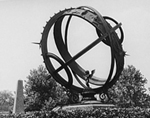|

|
Washington
|
Sundial: 284
|
| State/Province: District of Columbia |
Country: United States |
| Dial Type: Armillary Sphere |
Condition: No Longer Exists |
| |
Latitude and Longitude: |
38° 55.171' N 77° 2.137' W |
| Location: |
- The Noyes Armillary Sphere was installed at the bottom of the Great Cascade of Meridian Hill Park in the 1930s. The sphere was vandalized in the 1960s and later disappeared after it had been removed from Meridian Hill Park for repair in the late 1970's.. The dial was originally at the south end of the park, near the reflecting pool. A new replica dial has been reinstalled in Meridian Hill Park
|
| |
| Description: |
- The original Noyes armillary sphere was donated by Bertha Noyes in honor of her sister, Edith. Made of copper and bronze, the 6-foot armillary had an equatorial band with symbols of the zodiac, a meridian circle and arctic & antarctic circles. A winged cherub — a putto — stood in the center. The dial sat upon a octagonal polished green granite base.
John Kelly of the Washington Post reports that, "All that remains of the once-mighty orb is the octagonal granite base it sat upon at the south end of the park, near the reflecting pool, now largely obscured by a circular hedge. The Park Service also has the winged baby that once stood inside the sphere. It is safely archived at a facility in Landover, MD...The Park Service isn’t sure when [the dial] was removed — after 1977 and before 1985. And, embarrassingly, they aren’t sure where it is now. They don’t know whether it was stolen while awaiting repairs or just misplaced."
Artist C. P. Jennewein best known for monumental sculptures, including eagles that adorn Arlington Memorial Bridge and the entrance to Arlington National Cemetery. The dial cost $31,199 to erect. The land comprising Meridian Hill park was purchased by Congress in 1910, due in part to the efforts of Mary Foote Henderson, a private citizen and park advocate with considerable real estate interests in the area. The first plans for the park were drawn up by landscape architect George Burnap, and approved by the Commission of Fine Arts in 1914. Burnap's Italianate design suited the steep topography and exploited the views from the crest of the escarpment.
In November 2024 an exact replica of the 6-foot 6-inch (2m) dial was reinstalled by the National Park Service thanks in part to a generous and anonymous donor. The NPS describes the armillary: "The original sphere was laid out in two equal circles that crossed each other at right angles and bisected one another. One circle represented the Meridian and the other the Equator. The meridian was divided into four 90° areas and the equator into 360°. A third circle, the Ecliptic, passed obliquely through the meridian and equator and intersected the equator at an angle of 23 1/4° at two points known as the equinoxes. Two smaller circles at either end represented the Arctic and Antarctic regions and were placed at a position 23 1/4° from their respective poles. A circle representing the line of longitude was placed at right angles to the meridian but bisecting the sphere east and west and thus passing through the north and south poles. A bronze gnomon shows the Axis of the earth and casts a shadow upon the equatorial band. On the inside of this band are represented the minutes of the day in 5 minute increments and there are star symbols that represent the hours of the night." The NPS oversaw the re-creation of the new armillary sphere, which was designed using historic photographs and drawings, including the putto.
"Meridian Hill Park is a beloved park to many Washingtonians," Superintendent Brian Joyner said. "We are committed to revitalizing the park’s historic features and sharing its unique stories with the community."
|
| |
General Information: | - Owner: US National Park Service
|
- Designer: C. Paul Jennewein
|
- Builder: C. Paul Jennewein
|
- Construction Date: Original 1936, Removed 1970's, Newly rededicated Nov 2024
|
| |
| Web Links: |
|
Last Revised: 2025-02-14 15:19

